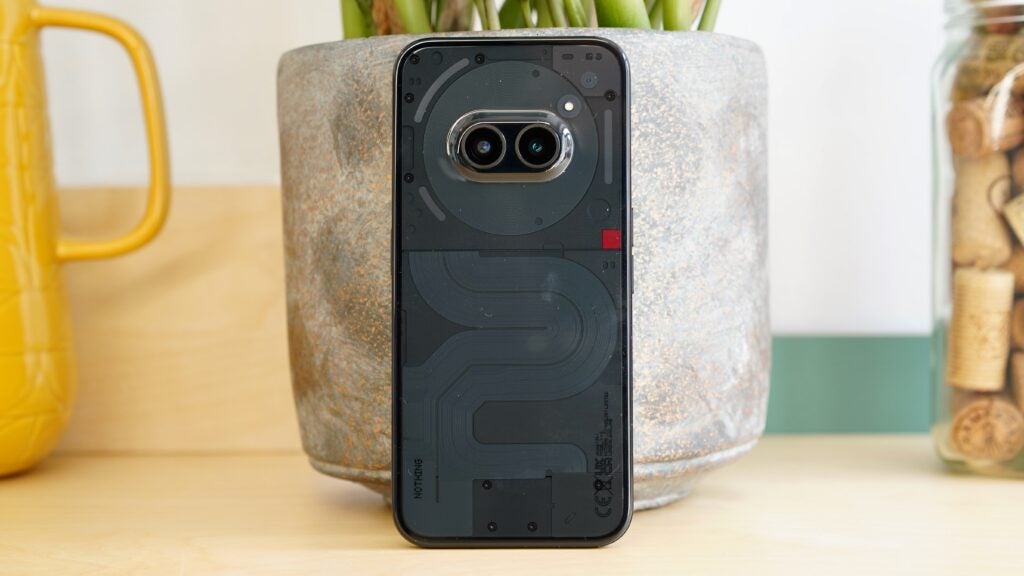Nothing CMF Phone 1 vs Nothing Phone (2a): What’s the difference?

Nothing recently announced the CMF Phone 1, a true budget phone from the company’s affordable sub-brand.
So, how does it compare to one of Nothing’s own cheap phones, the Nothing Phone (2a)? Keep reading to learn how these two smartphones compare.
The Nothing Phone (2a) features Nothing’s Glyph lights
Nothing’s visual signature is its Glyph lights and the Nothing Phone (2a) features a slightly more simplified version of the Phone (1) and Phone (2)’s 11 LED array. Instead, the Phone (2a) features just three LEDs that light up to signal incoming notifications, provide visual feedback for camera timers, or whatever else you choose to programme them to do.
Nothing has completely forgone the Glyph lights on the CMF Phone 1, instead opting for a more simple-looking but no less interesting modular design.
The Nothing CMF Phone 1 has a modular design
As mentioned, the Nothing CMF Phone 1 features a unique, modular design.
The back casing of the MF Phone 1 can be removed and swapped out to change the colour of your phone whenever you feel like a change, with each additional case costing about £30 a piece. This is also a great feature for those prone to dropping and scratching their phones, giving you the option to replace the back casing for less than the typical repair charge.
There’s also a small wheel screw called the Accessory Point at the bottom edge of the phone. There’s a lanyard hook, a kickstand for propping the phone up when watching videos and making calls and a magnetic backplate that comes with a magnetic card wallet comparable to Apple’s MagSafe accessories (minus the wireless charging capabilities).

The Nothing Phone (2a) features an ultra-wide camera
When it comes to the camera, both phones are led by a sharp 50-megapixel rear sensor. However, only the Nothing Phone (2a) features a second 50-megapixel ultra-wide angle camera.
We found this second camera to offer adequate results, but it doesn’t match the main sensor for detail or dynamic range.
The Nothing CMF Phone 1 has a brighter display
While the Nothing Phone (2a) is generally a step above the cheaper Nothing CMF Phone 1 when it comes to specs, one area in which the CMF Phone 1 does shine is its display, which we found to be big, bright and vibrant.
The CMF Phone 1 features a 6.67-inch AMOLED display with a 120Hz refresh rate and 2000 nits of peak brightness. The Phone (2a) also features a 6.7-inch AMOLED display with a 120Hz refresh rate, but this phone peaks at 1300 nits of peak brightness, leaving it 700 nits behind the CMF phone (though still very bright).

The Nothing Phone (2a) packs a Pro chipset
Finally, it’s worth noting that the Nothing Phone (2a) is powered by a slightly more powerful chipset than the Nothing CMF Phone 1.
The Nothing Phone (2a) is powered by a custom-tuned version of the Mediatek Dimensity 7200 Pro paired with up to 12GB of RAM. While this chipset falls far short of the Snapdragon 8 Gen 1 found in the Nothing Phone (2), it nevertheless offers solid performance for its price and was able to handle 30 minutes of light gaming, followed by 20 minutes of sustained 3D gaming in our tests.
The Nothing CMF Phone 1, meanwhile, runs on the MediaTek Dimensity 7300G with 8GB of RAM. Again, this is a budget chipset, but we found the phone capable of handling a solid 30 minutes of Mario Kart Tour with the handset getting warm or the performance stuttery. That said, don’t expect to be able to play many games at their highest graphics settings.









